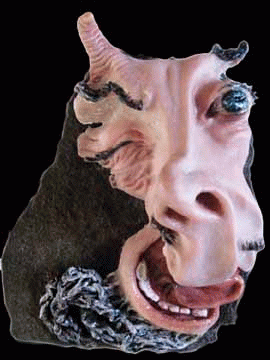Pan contemplates Pandora's box by by j dial
As we've all heard, hydraulic fracturing releases natural gas contained in deeply buried shale formations. I wondered about the association between shale and natural gas. In researching that connection, I came across something unexpected. This section describes the shale-gas connection and the next reveals its largely understated threat. Finally I describe oversight.
Hiding in Plain Shale ...
We learn in grammar school that rock falls into three basic categories--igneous, metamorphic, and sedimentary. When you think about it, distinctions we make among rocks composed of mingled elements must be subjective, for the crust cooled from elements well shaken and stirred. Nevertheless, after those cooling periods (and there have been several) things happened, and on those events we base our distinctions. Igneous cool out of magma, forming crystals, and include basalt, granite, obsidian, quartz, and rhyolite; metamorphic have changed, in effect being born again by temperature and pressure, and include schist, slate [1], and marble; and sedimentary are crushed beneath the bulk of land or sea, and include chalk, coal, flint, and sandstone. Sedimentary rocks can be 'organic'--not because they're free of contagion, but rather because they contain debris from organic processes.
Shale is a sedimentary rock, formed by clay-sized minerals that blanketed the bottoms of ancient seas. Although gravel, sand, silt, or clay can make sedimentary rock, only clay makes shale. A claystone must have at least twice as much clay as silt and no more than ten percent sand. [2] Even with all that, however, a claystone may still not make the shale grade. What makes a claystone into shale is its fissility--its tendency to split into layers. Shale is usually soft and, with exposure, easily returns to clay. It can be seen along roadcuts resembling drunken parallels of flagstone (which is also sedimentary).
Geologically the Devonian period, about 400 million years ago, has been called the "age of fishes" because fish proliferated in that time of warmth and widespread seas. Fish did so well, in fact, that some grew legs and found novel new uses for them. It was during this time that many of the small, plankton-like lifeforms, far down the food chain that populated those seas, when that avoided being eaten, eventually died of other causes. Their little bodies fell through warm and sunlit waters into colder and oxygen-low waters far below, where, relatively free from decomposition, the bodies piled up like product of a busy serial killer. The end of that period, about 345 million years ago, was marked by a mass extinction, probably caused by glaciation or a meteor impact. In that extinction about 30 percent of all animals including fish perished, adding greatly to the bodily debris in the depths.
Next Page 1 | 2 | 3 | 4 | 5 | 6
(Note: You can view every article as one long page if you sign up as an Advocate Member, or higher).






